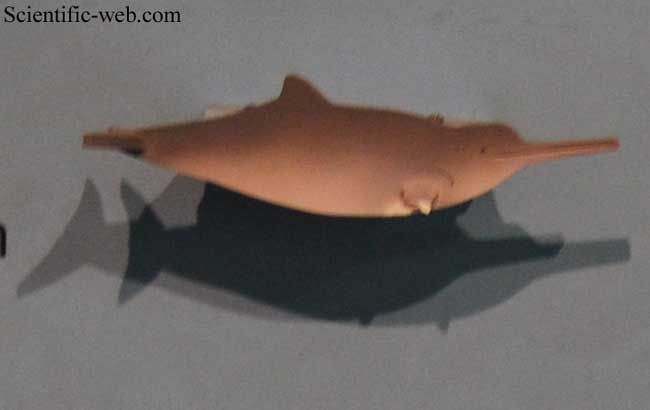Pontoporia blainvillei, Photo: Michael Lahanas Cladus: Eukaryota Name Pontoporia Gray, 1846 References * Pontoporia on Mammal Species of the World. Vernacular names ----------- The La Plata Dolphin or Franciscana (Pontoporia blainvillei) is found in coastal Atlantic waters of southeastern South America. Taxonomically it is a member of the river dolphin group and the only one that actually lives in the ocean and saltwater estuaries, rather than inhabiting exclusively freshwater systems. The La Plata Dolphin is the only species in its genus, and is often placed in its own family, the Pontoporiidae. It was first described by Paul Gervais and Alcide d'Orbigny in 1844 (the species epithet blainvillei commemorates the French zoologist Henri Marie Ducrotay de Blainville). The La Plata Dolphin is also widely known as the Franciscana - the Argentine and Uruguayan name that has been adopted internationally. Other common names are the Toninha (the Brazilian name) and Cachimbo. Physical description The La Plata Dolphin has the longest beak (as a proportion of body size) of any cetacean — as much as 15% in older adults. Males grow to 1.6 m (5 ft, 3 in) and females to 1.8 m (5 ft, 10 in). The body is a greyish brown colour, with a lighter underside. The flippers are also very large in comparison with body size and are very broad, but narrow on joining the body and so are almost triangular in shape. The trailing edges are serrated. The crescent-shaped blowhole lies just in front of a crease in the neck, giving the impression that dolphin forever has its head cricked upwards. The dorsal fin has a long base and a rounded tip. The La Plata Dolphin weighs up to 50 kg (110 lb) and lives for up to 20 years. The gestation period is around 10–11 months and juveniles take just a few years to mature. Females may be giving birth by the age of five. The animal is very inconspicuous - it moves very smoothly and slowly—and can be difficult to spot unless estuary conditions are very calm. They will commonly swim alone or in small groups. Exceptionally groups as large as 15 have been seen. La Plata Dolphins are bottom feeders and gut inspections have revealed they eat at least 24 different species of fish, depending on which species are most common. They will also take octopus, squid and shrimp. They are, themselves, hunted by orca and several species of shark. Range and habitat The La Plata Dolphin is found in the coastal Atlantic waters of southeastern South America, including the Río de la Plata estuary. Its distribution ranges from the Tropic of Capricorn near Ubatuba, Brazil, south to Península Valdés, Argentina. It is the only member of the river dolphin group that actually lives in the ocean and saltwater estuaries, rather than freshwater. Although some members of the species do spend portions of their lives outside of river systems, there are many individuals who live their entire lives within rivers, never venturing into the ocean proper. Conservation The La Plata Dolphin is listed as "data deficient" in the IUCN Red List of Threatened Species. However the Franciscana is a particular conservation concern because of its restricted distribution and vulnerability to incidental capture in fishing gear. Large numbers are killed in gillnets. Although the largest documented catches in the 1970s were in Uruguay, catches in recent decades have also been high in southern Brazil and Argentina. Scientists from all three countries have voiced their concerns, and asked for international assistance in highlighting the plight of the dolphin (see Reeves et al., pg. 53). References 1. ^ Reeves, R.R., Dalebout, M.L., Jefferson, T.A., Karczmarski, L., Laidre, K., O’Corry-Crowe, G., Rojas-Bracho, L., Secchi, E.R., Slooten, E., Smith, B.D., Wang, J.Y., Zerbini, A.N. & Zhou, K. (2008). Pontoporia blainvillei. In: IUCN 2008. IUCN Red List of Threatened Species. Downloaded on 24 March 2009. Database entry includes a brief justification of why this species is of vulnerable. Source: Wikispecies, Wikipedia: All text is available under the terms of the GNU Free Documentation License |
|

